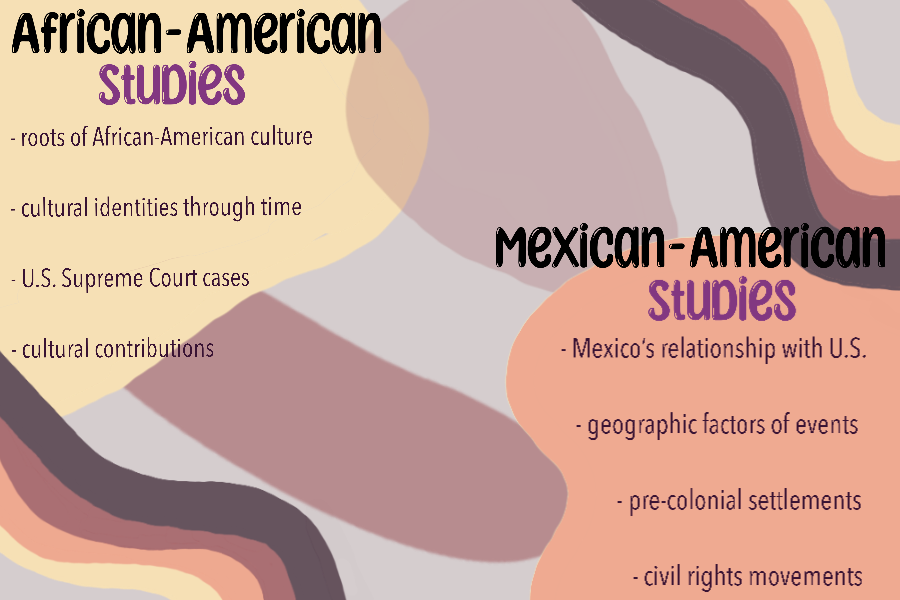History written by more than victors
New ethnic courses to be offered at Coppell High School
Coppell High School offers new ethnic courses in the 2022-23 school year. Students will be expected to learn about changes in culture, conflicts and civil rights of Mexican and African-Americans.
Coppell High School is adding to its history course options in 2022-23 in an effort to provide a more detailed view of history through the lens of minorities.
“One of the things that marks modern history from other eras is that there is a lot of discussion about not just teaching the stereotypical winner’s version of history,” CHS social studies teacher Shawn Hudson affirms. “You know that thing everybody always says: that history is written by the victors. But, we do not have to settle for that in the modern world.”
The new courses, commencing in the 2022-23 school year, were implemented to increase inclusion.
“As a district, we felt it was important to offer these courses to our learners as it aligns with our goals of promoting respect and understanding of diverse cultures and expanding opportunities for our students to see themselves in history,” Coppell ISD director of social studies Maria McCoy said in an email.
CHS head counselor Ann Cinelli was also quick to share her excitement.
“I love it,” said Cinelli, with a chuckle. “Like why have we not done this already, finally.”
Texas’s new Texas Educational Knowledge Standards (TEKS) for the courses helped structure the classes.
“From a behind-the-scenes standpoint, we can’t just create a course out of nothing,” Cinelli said. “The state of Texas has to have TEKS for it. We had to wait for the state to get there too, which was unfortunate. But we were like, maybe it will be coming. Maybe it will be happening. ”
CHS social studies teacher and debate coach SunHee Simon took African-American studies at Stanford University and thinks it was essential in learning the full history of the United States.
“Going into [the class at Stanford], I wanted to make sure that I had an open mind,” Simon said. “Knowledge is power and learning more about how the world works and how different people at different points of history were denied, had access, or created resistance was really interesting for me to learn about.”
The new ethnic courses also circumvent problems teachers face in other history courses, particularly the limited time frame.
“I can’t teach you all of world history since 1200 in 30 weeks,” Hudson said. “So, getting to be in one of those classes as a student would be really valuable to get a different side of the story that you cannot get from a mainstream survey course.”
According to Hudson, the highlight of being a history teacher is teaching all of history, the good and the bad, and it is those conversations that enable students to analyze current events and controversies.
“The ethnic studies courses are really cool because it allows you to drill into a part of history that is not taught because these are ethnic minorities within the United States,” Hudson said. “This means they are very rarely that top level of what we are teaching. But, the minority experience is deeply interesting to our character because how we have treated those groups contextualizes who we are, not just who we say we are. It gives a fuller picture.”
Cinelli thinks the uncomfortable conversations the course will enable are necessary for CHS learners to understand race.
“It will totally help kids to see another side of history because they might be like ‘I learned this is United States history, but I didn’t know this side of it,’” Cinelli said. “Like, what actually happened? It uncovers a lot and is a great opportunity to have uncomfortable conversations about how our country has not handled race in the best way.”
Especially in Coppell, where a majority of students are people of color, courses like these reflect the students themselves.
“We are a very diverse population,” Hudson said. “And while there is no Asian-American studies course, I still think you can get a lot out of seeing African-American studies and Mexican-American studies because they are going to share that minority experience.”
Because the classes are Level III Honors, they are intellectually engaging in terms of content. In fact, the course curriculums target various aspects of history such as geography, economics, citizenship, culture and science.
It is currently not confirmed if both courses will be taught, given the lack of enrollment. Although there are enough students for an African-American studies course, Mexican-American studies still requires more students.
There is hope though.
“We ask that every class has 15 students in order to make the class,” Cinelli informs. “Once we start making those changes for dual credit, we will get to see if enough students move to Mexican-American studies.”
Follow Anushree De (@anushree_night) and @CHSCampusNews on Twitter.

Anushree De is a senior and the features editor of The Sidekick, where their passion for storytelling flourishes. Their favorite films, La La Land, Zootopia,...








